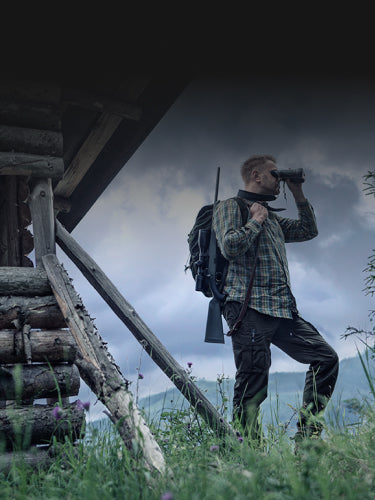Thermal imaging is a technology that allows us to see heat signatures in any light condition. It's commonly used in cameras but can also be found in devices like riflescopes and binoculars. Nowadays, thermal technology is used for hunting, security, wildlife observation, and surveillance in addition to its traditional roles in the industrial and medical industries.
How Does It Work?
Thermal imaging works by detecting infrared light, which is invisible to our eyes. All objects emit infrared light based on their temperature. The hotter an object is, the more infrared light it emits.
The visible light spectrum, which we can see, ranges from 380nm (violet) to 750nm (red). The infrared spectrum, just next to the visible spectrum, includes:
- Near-IR: 750nm to 1400nm
- Short-wave IR: 1400nm to 3000nm
- Mid-wave IR: 3000nm to 8000nm
- Long-wave IR: 8000nm to 15000nm

Seeing Heat with Thermal Imaging
Thermal imaging allows us to see temperature variations. Hotter objects emit more infrared energy. Thermal imagers use a special sensor called a microbolometer, which detects infrared light and turns it into an image we can see. These images are usually shown in shades of black and white or in color.
Types of Thermal Imaging Devices
There are two main types of thermal imagers:
- Uncooled: These are more common and compact. They work at normal temperatures and are less expensive.
- Cooled: These are cooled to very low temperatures for better performance. They're more expensive but provide higher quality images.
Advantages of Thermal Imaging
- Can see through smoke and fog
- Works in complete darkness or bright daylight
- Can detect hidden objects based on their heat signature
Disadvantages of Thermal Imaging
- Can't see through glass (it appears as an opaque surface)
- May have difficulty distinguishing between heat sources and heat reflections
Thermal Sensors
Thermal cameras use different types of sensors, which detect different ranges of infrared light:
- SWIR (Short Wave Infrared): Can partly see through smoke and haze and can see through glass.
- MWIR (Mid Wave Infrared) and LWIR (Long Wave Infrared): These are completely passive, needing no external light. They're great for seeing through smoke, dust, and fog, but can't see through glass or water.

A comparison of visible light and short wave infrared (SWIR) imaging. The liquids in the bottles in the left panel become opaque, regardless of the transparency of their containers, while the bridge in the right panel becomes visible under the fog if viewed through SWIR.

The image in long wave infrared shows the operators obscured by the smoke.
Important Factors in Thermal Imaging
- Resolution: Higher resolution means more detailed images.
- Pixel Pitch: Smaller pixel pitch generally means better performance and more compact devices.
- Frame Rate: Higher frame rates (like 30 Hz or 60 Hz) produce smoother video.
- Focal Length: Longer focal lengths allow you to see further, but may result in a larger, heavier device.
- Objective Lens Size: Larger lenses gather more light, producing better images, but also make the device heavier.
Range of Observation
How far a thermal device can see depends on many factors, including the device's specifications and environmental conditions. Thermal imaging devices typically have three range categories:
- Detection: Able to tell that something is there, but not what it is.
- Recognition: Able to tell what type of object it is (e.g., person, car, animal).
- Identification: Able to identify specific details about the object.
Thermal cameras can see in complete darkness and through light rain or fog. However, dense rain and fog can limit their range because they scatter infrared light and cool the surfaces of targets, reducing contrast. Despite this, thermal imaging often performs better than night vision devices in similar conditions.
To shop Pulsar thermal devices, click here.
Frequently Asked Questions
How does thermal imaging work?
Thermal imaging works by detecting infrared light, which is invisible to our eyes. All objects emit infrared light based on their temperature.
What are the advantages of thermal imaging?
Thermal imaging can see through smoke and fog, work in complete darkness or bright daylight, and detect hidden objects based on their heat signature.
What are the disadvantages of thermal imaging?
Thermal imaging can't see through glass and may have difficulty distinguishing between heat sources and heat reflections.
What types of thermal imaging devices are there?
There are two main types of thermal imagers: uncooled and cooled, each with their own advantages and disadvantages.
What are important factors in thermal imaging?
Resolution, pixel pitch, frame rate, focal length, and objective lens size all play a role in the performance and capabilities of thermal imaging devices.




